There is a dragon on this coin, and it is covered in Chinese characters, therefore several readers assumed it was a Chinese coin… This is actually a Japanese coin. Subsequent strikes of this type of coin include an English face value of “One Yen“, which helps avoiding this mistake, but the coin above is a one year type, with no English legend at all, making its proper identification somewhat more tricky if you are unable to read Chinese characters. While the focus of this blog is clearly Chinese coins, I thought it could be interesting to write an article about this particular dragon dollar.
The strike of western-style round coins began earlier in Japan than in China: the coin above was minted in 1870, the year of the currency reform edicted by the Emperor Meiji (also known by his personal name, Mutsuhito). Seeking to modernise the country and bring it to western standards of the time, the Emperor Meiji replaced the ancient and complicated monetary system by a bi-metallic, western-style currency backed by gold and silver to facilitate trade with foreign countries. Due to the round shape of the dollar sized coins, the new currency was called “Yen“, using the same traditional Chinese character 圆 (Yuan) than in China. The symbol was later simplified as 元 in China, and 円 in Japan, which are now respectively used as the Yuan and Yen currencies symbols.
On the obverse, the coins depicts the Japanese dragon holding the pearl of wisdom. One can note that while the Chinese imperial dragon has always 5 claws, this Japanese dragon has only 3 toes. In Japan as in China, the Emperor was said to be the descendant of dragons. In China, the story goes that dragons originated in China and lost toes as they went farther and farther, until they could not walk anymore. This is why the Korean dragon has 4 claws and the Japanese dragon 3 toes. But there is a long time rivalry between China and Japan, and in Japan people say that dragons actually came from Japan, and grew more claws as they went further away…
The reverse is actually more helpful for identification purpose: it shows the characteristic rising sun symbol and the imperial seal of Japan, a 16 petals chrysantemium flower.
This dragon dollar is known in western catalogues as Y5, type 1 or type 2. But what is the difference between these “types”? This information is surprisingly difficult to find online. There is actually 3 main versions of the 1870 Japanese yen, which only differ in the way the 圆 character was written. The most common is the type 1, as shown at the beginning of this article.
The type 2, also called “正貝円” in Japan (正贝元 in China), is much scarcer. The difference resides solely in a tiny detail of the 圆 character: on the common version, the left stroke at the bottom of the 貝 part of the character is too short, incomplete. On the type 2, the stroke is longer, complete – that is why this type is called “Correct 貝 Yen”.
There is also a third version, very rare and expensive, called “欠貝円” in Japan (“Defective 貝 Yen”). The 圆 character on this die variation is lacking one stroke, effectively creating a yawning gap in the middle of the character.
There is more die variations (手変わり in Japanese) of the early Yen coins, but they are minor and have less impact on the price than the 3 shown above.
The Meiji 3 silver yen is one of the scarcest Japanese coins, however it is still much cheaper than a lot of Chinese coins. You can buy a mint state type 1 1870 Yen for about $1000 USD at current prices.
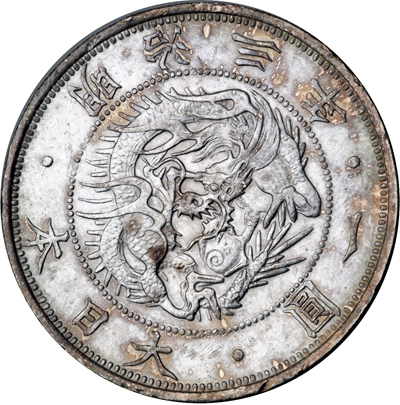
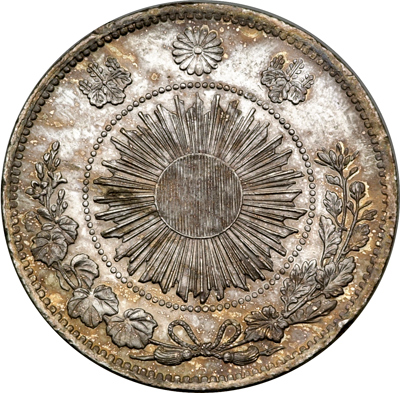
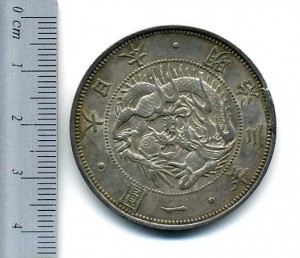
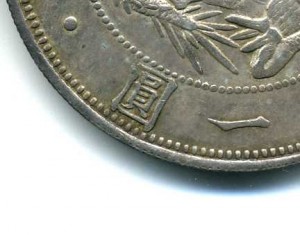
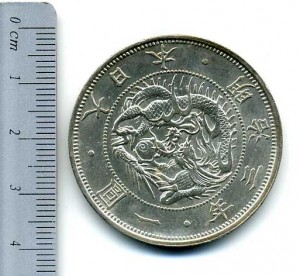
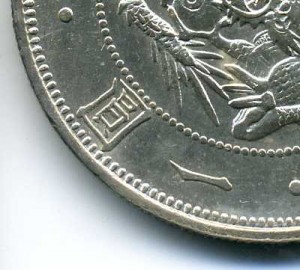
i found a similiar head but with a different back. instead of a ‘sun’, mines a 2 flag. any idea about that?
Is your coin silver, and if so is the head completely identical? Japanese coins with the crossed flags are usually made in gold, or smaller silver denominations.
I have a Japanese Dragon Dollar, I believe is a Type 2. I am having a hard time finding out how much it is worth, can you help me?
Hello, according to the pictures you uploaded on Facebook, I think your Japanese silver dollar is actually a Type 1, in XF condition. It should be worth anywhere around $300 USD.
I have a similar coin as well, same front and back but there are some extra characters on the front…
FRONT: [IMG]http://i1359.photobucket.com/albums/q792/Brad_Massd_Conner/japanesecoinfront_zpsc81a2038.jpg[/IMG]
REAR: [IMG]http://i1359.photobucket.com/albums/q792/Brad_Massd_Conner/japanesecoinback_zps1e875fe5.jpg[/IMG]
Hello, your coin is indeed different – it is a 1871 (4th year of Meiji) 50 sen silver coin (half dollar). This coin is also quite scarce, and there exists 2 types. You have the most common type I, large dragon, like this one: http://stacksbowers.com/auctions/AuctionLot.aspx?LotID=378092 worth about $100 USD.
The small dragon is more expensive: http://www.liveauctioneers.com/item/5616880
Dear Sir,
I am very impressed of your knowledge on the subject matter. May I submit a sample of a dragon coin I purchased on eBay for you to take a look and determine its authenticity?
Hello,
Sorry for the late reply! I will of course be glad to help you.
Please send clear pictures of your coins using the Appraisal Form here:
http://www.dragondollar.com/coins/coin-appraisal-what-is-your-chinese-coin-worth/
or simply post them on my Facebook page here: https://www.facebook.com/DragonDollar
Can any one help me identify this coin?
I have an orential coin that looks either Japanese or Chinese. one side has at the top “IIO_NAN” and at the bottom “200 CASH” there are two flags with crossed shafts. One of the flags has what looks like a sunflower and the other is worn smooth.
JLindley
Hello, your description matches a somewhat uncommon Chinese copper coin from the Hunan province.
Does it match the picture from the link below?
http://www.coinarchives.com/w/lotviewer.php?LotID=1482980&AucID=1363&Lot=53115&Val=3714ee85aba18a33684dc8b631e3522f
Hi, I recently recieved two coins and thanks to your blog I have identified one of them as the Japanese Yen from 1870.
The other coin looks the same as the Japanese 1870 Yen but instead of a rising sun the are two crossed flags in the middle and the dragon is very slightly different. Other than that it is the same size, same material, with every other character and picture the same. Do you have any idea what this is?
Hello Jan, I suspect both coins may be fake, as the crossed flag version is a type of fantasy coins sold as souvenir in China.
Please send pictures of your coins with the appraisal form, I will check them and tell you if they are genuine:
http://www.dragondollar.com/coins/coin-appraisal-what-is-your-chinese-coin-worth/
I have a dragon dollar that I need help determining whether it’s a fake or real can somebody get back to me and I have a few other ones that need help with that
I have one that’s so old the writing is basically gone on it…??